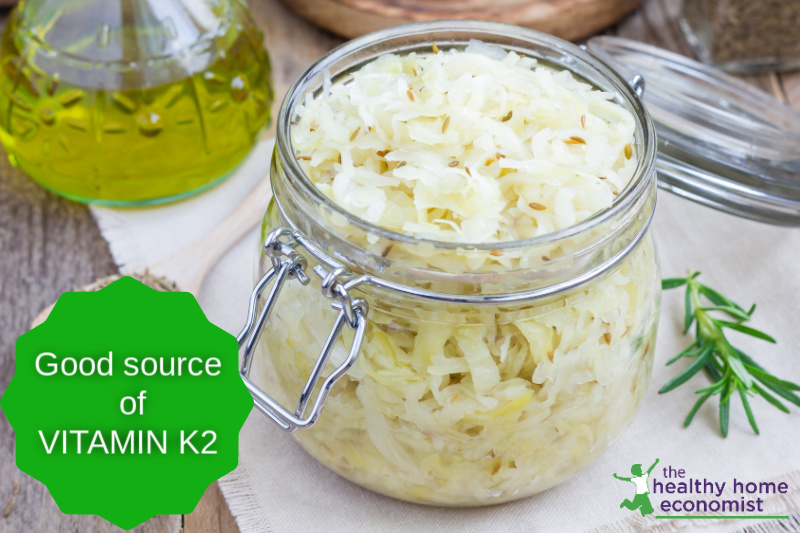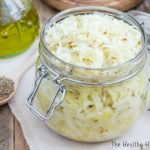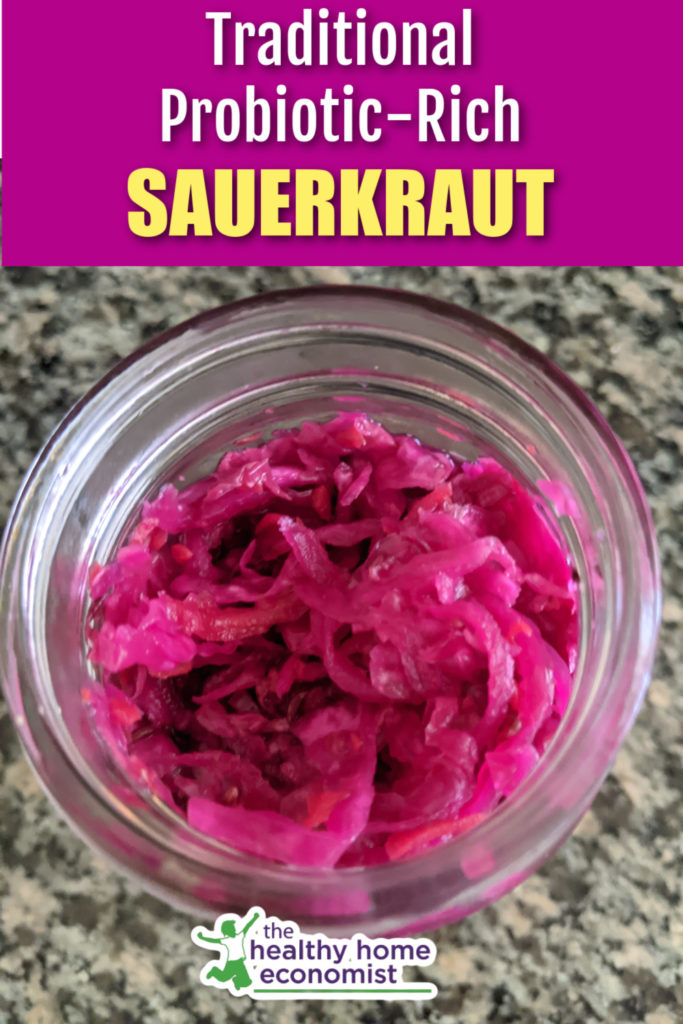Recipe and detailed video instruction on how to make traditional sauerkraut that is loaded with probiotics and Vitamin K2 for better digestion and health. 
By popular demand, the process of making homemade sauerkraut is explained and demonstrated in the two video lessons below. The written recipe is also provided by those who wish to dive right in.
This traditional food is probiotic-rich and very nutrient-dense unlike the vinegar-packed sauerkraut wanna-be’s at the store.
The first video covers a brief history of sauerkraut and what you need on hand to make it. The second video covers how to make sauerkraut yourself quickly and easily in your kitchen.
The sauerkraut recipe I use is based on the Nourishing Traditions method.
Benefits of Fermenting Cabbage
Eat small amounts of this probiotic-rich condiment with cooked foods to improve digestion and assimilation.
Remember that fermenting does not reduce the goitrogens (thyroid suppressing substances) in the cabbage. So, if you have thyroid issues, you may wish to consider avoiding this particular condiment.
If your thyroid status is good and you eat plenty of iodine-rich foods like grassfed butter, then sauerkraut is a healthy addition to the diet.
Loaded with Vitamin K2
Did you know that properly cultured cabbage contains a significant amount of natural Vitamin K2? This is an elusive nutrient that is very hard to get in the diet. It is essential for strong bones and healthy teeth.
The USDA reports that one cup of sauerkraut contains 81 mcg. No doubt this is the commercial, pasteurized stuff that the USDA is testing too.
I would venture to suggest that making raw sauerkraut yourself and fermenting properly would potentially contain larger amounts.
Natural Remedy for Reflux
Another bonus of eating raw fermented cabbage is that it is a natural way to prevent acid reflux. Simply eat a mouthful or two a few minutes before the start of a meal.
Want to experience these benefits for yourself? Two detailed video lessons are included with the recipe below.
Tip: Be sure to wear an apron when you make this dish as you will see in the video! ?
Why don’t you try it today! You will never go back to the pasteurized, shelf stable sauerkraut at the store!

Homemade Sauerkraut Recipe
Basic recipe for homemade sauerkraut as traditionally made as a live cultured food loaded with probiotics and enzymes to aid digestion and absorption of nutrients.
Ingredients
- 1 green or purple cabbage medium size, preferably organic
- 4 Tbl liquid whey
- 1 Tbl caraway seeds
- 1 Tbl sea salt
Instructions
-
Core and chop cabbage. Place all the chopped cabbage and other ingredients together in a large sturdy bowl.
-
Pound the juices out of the cabbage thoroughly with a kitchen pounder of some kind for a full 10 minutes.
-
Tightly pack the cabbage into a one quart mason jar leaving at least 1 inch of space at the top. Tightly seal with the lid.
-
Leave on the counter for 3 days and then refrigerate.
-
The flavor of the homemade sauerkraut improves over time. It will last many months in your refrigerator or cool cellar.
Recipe Video

References
(1) Vitamin K2 in Sauerkraut
(2) Nourishing Traditions
More Fermented Food Recipes
Love this sauerkraut recipe? Try these other delicious fermented foods and drinks below and unleash the power of a traditional diet in your home.
How to Make Fermented Lemonade
How to Make Orangina
Mango Chutney Recipe
Homemade Apricot Butter
Fermented Potatoes
Probiotic Corn Relish
How to Make Fermented Cilantro Salsa
Beet Kvass Recipe








Ok, I just made my first batch of sauerkraut based on your video, and used whey from clabbored milk based on your other video. Three days and counting! I’m going to make some fermented lemonade in a couple of days.
I don’t do the cooking in my house, but I sure am having fun learning about the healthy side of eating, as well as making these foodie projects. I never thought it would be this simple, and I REALLY never thought healthy food could ever taste good. Thanks for showing me otherwise.
Thanks for putting these videos together. They’re just great!
Does heating the kraut to eat it, does the heat destroy the beneficial bacteria and enzymes? I made a Reuben with mine and then wondered if heating it defeated the purpose. Thanks!
Tami,
When I do sauerkraut I sterilize with boiling water my jar, cutting board, bowl, knife and a kitchen pounder and wash my hands very well!! I wash a counter with vinegar. I am very careful not to contaminate cabbage with bad bacteria from environment.
I grate my cabbage. Take 1 tablespoon for 1 kg of cabbage. I put grated cabbage into a glass bowl (Pyrex) sprinkle with sea salt and pound it with a clean pounder. I cover it with a plate.
After about 4 hours when it softens I tightly pack it into a sterilized jar with a clean spoon and pound it well. I use for pounding a glass bottle or a small jar because glass is the best material for keeping bacteria away. A juice should come to the surface.
Sealed jar I put into a dark cupboard (I heard that it is better that way).
After 2-3 days I open a jar and pound my sauerkraut once more to make sure that a cabbage is covered with a juice.
I leave it for another 3 weeks in the cupboard ( I was told that good bacteria needs 3 weeks of fermentation process). After that time I put it into a fridge. Ready to eat.
Hi Sarah!
I used fresh goat milk to make my whey and cream cheese. I didn’t let it sour first, but just left it fresh on the counter and waited for it to “klaver” (not sure if I spelled that right) and then let it strain through a nut milk bag. The cheese tastes like yeast. Is that the way it’s supposed to be? Can it klaver properly if the milk isn’t sour? I’m asking. Because I made sauerkraut with the whey and it’s puffing up with air pockets in it. Did I do something wrong? Do I open it and push it back down? Oh and is the goat cheese ok to eat if it tastes like yeast?
Thanks for any help you can give on this!
I’ve recently read where other Traditional Food bloggers are saying whey is not necessary for the fermentation of vegetables. Others say the product won’t have good bacteria without it. I’m new to this and am trying to do what’s best. What are your thoughts on this? Thanks.
oops, means Raw
Hi sarah again I forget to ask you can I use the whey from my rwa goat milk kefir,thanks
Hi Sarah can I used the same method for the cauliflower and carrots as well,thanks I love all your videos, thanks for all your effort, well looks like you enjoy what you do, please answer me as soon as you can ,(if is possible) I ask you few things in another videos but maybe you didn’t see it,thanks a million again,maggie , you are becoming my hero in the kitchen
Hey
Interresting blogg you have, lots of good information.
I made sourkraut 1 week ago and im not sure if I did it right.
I used the recipe on the page, but I couldn’t get the cabbage to stay under the liquid the whole time when it was fermenting. Can’t see any mold and the smell is not bad.
So my question is:If the cabbage can be bad for me even if I can’t see any mold and the smell is allright?
For those looking for a easy tool to push veggies down into wide mouth mason jars. They have wooden stompers for use with meat grinders for under 10.00 at Lehman’s. Non electric online. I love mine and works great for packing down into jars.